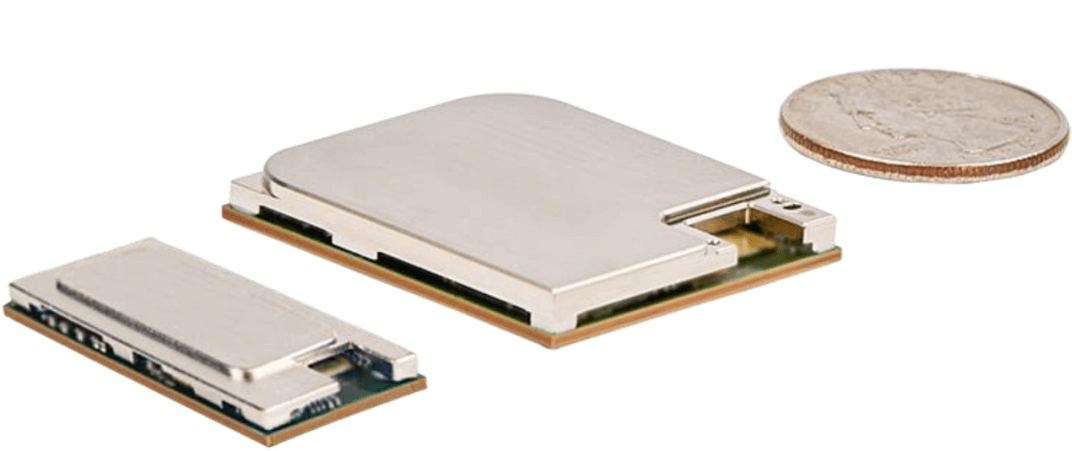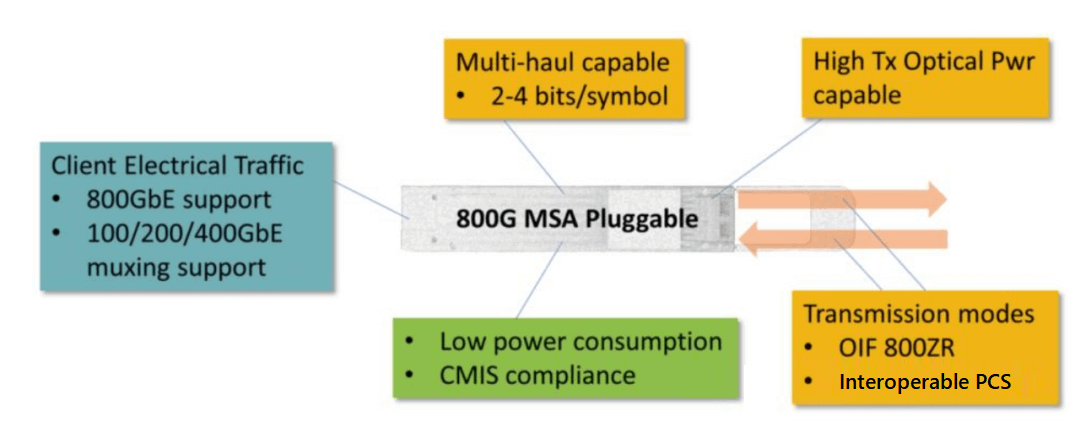Abstract
The increasing bandwidth demand of hyperscale data centers is driving the development of 800G OSFP/QSFP-DD. The next-generation pluggable modules will leverage higher baud rates, standardized protocols, and advanced integration to achieve 800G transmission in small form factors. Key features such as 800GbE support, multiple client rates, interoperable modes, and low power consumption will accelerate their commercialization. With mature silicon photonics technology and three-dimensional packaging technology, 800G OSFP/QSFP-DD is expected to achieve large-scale deployment in 2024.
Introduction
The continuous growth of data center traffic is driving the development of higher capacity and more efficient optical interconnect technologies. 400G OSFP/QSFP-DD with 60G baud rate signals have been successfully deployed in the past few years, but the focus is now shifting to the next-generation 800G OSFP/QSFP-DD.
Hyperscale data centers are expected to lead the transition to 800G OSFP/QSFP-DD, demanding 800G ports for the next-generation switch and router platforms. Similar to the 400G era, standardization organizations are pushing for the harmonization of parameters to ensure interoperability and economies of scale among multiple vendors. This includes doubling the baud rate to about 120G baud and increasing the channel spacing to 150GHz.
Advanced technologies such as silicon photonics, three-dimensional integration, and mixed-signal electronics enable the higher baud rates and modulation schemes required for 800G operation. Building on the validation of silicon-based 400G OSFP/QSFP-DD and performance-optimized modules, these technologies are now applicable to developing 800G pluggable optical modules in small form factors such as QSFP-DD and OSFP.
Key features such as 800GbE support, multiple low-rate clients, interoperable modes, high-transmit power products, and low power consumption will enable their application in various networks. With the convergence of technology and standardization, 800G OSFP/QSFP-DD is expected to achieve large-scale deployment around 2024.
800G Optical Standards Harmonization
Industry organizations such as OIF, Open ROADM, and IEEE are driving the harmonization of 800G standards to ensure interoperability among multiple vendors. This includes standardizing 800G optical parameters, client-side protocols, and module management interfaces.
In terms of optical transmission, OIF is defining 800ZR, which is an interoperable 800G coherent DWDM solution that achieves 80 km amplified link transmission using Class 3 optics with about 120 G baud rate signals and 16QAM modulation. Open ROADM also specifies an enhanced performance mode, which includes an interoperable implementation of probabilistic constellation shaping (PCS) for improving the optical signal-to-noise ratio, with an operating baud rate of 130+ G baud.

Figure 1. Doubling of baud rate and channel spacing from Class 2 at about 60+G baud to Class 3 at about 120+G baud (Source: Cisco)
On the client side, IEEE 802.3ck defines the physical layer specifications for 800GbE operation over 100γ interfaces. OIF and Open ROADM also support the multiplexing of lower-rate clients (such as 400GbE and 100GbE) over 800G optical links. In addition, OIF’s implementation agreement for the Common Management Interface Specification (CMIS) ensures interoperable management among multi-vendor pluggable modules. By harmonizing the optical, client, and management parameters, 800G standards will create similar economies of scale as 400G, while ensuring interoperability among multiple vendors.
Advanced Technologies for 800G OSFP/QSFP-DD
Leveraging advanced technologies such as silicon photonics, three-dimensional integration, and mixed-signal electronics is important for developing compact and efficient 800G OSFP/QSFP-DD.
Silicon photonics technology provides high-bandwidth density wavelength division multiplexing components, such as modulators, multiplexers, and photodetectors, that can be integrated into a silicon substrate. This technology enables the scaling of higher baud rates above 100G in a cost-effective and scalable manner.
Three-dimensional integration or siliconization technologies (such as flip-chip bonding, chip stacking, and high-density substrate packaging) enable tight integration of photonics and CMOS electronics. This integration can improve signal integrity and power efficiency at 800G rates.
The next-generation mixed-signal electronics, such as 112G per channel DAC and ADC performance enhancement, and new DSPs, enable the high-speed signals and complex modulation schemes required for 800G optical transmission.
These technologies have been validated in performance-optimized modules such as silicon-based 400G OSFP/QSFP-DD and Acacia’s CIM coherent modules, making them promising to support large-scale 800G OSFP/QSFP-DD development.

Figure 2. From left to right: 3D siliconization technologies for Class 2 MSA pluggable modules and Class 3 performance-optimized CIM 8 modules. Highly integrated co-packaging is critical for Class 3 800G MSA pluggable modules. (Source: Cisco)
Key Features for 800G OSFP/QSFP-DD Applications
To achieve successful large-scale applications, 800G OSFP/QSFP-DD needs to support some key features to meet the network application and industry development requirements. A major feature is to support 800GbE client traffic. It is expected that there will be 800G switch and router ports in 2024, and to interconnect these platforms, pluggable modules need to have native 800GbE capability. During the transition period when lower-rate clients such as 400GbE and 100GbE are still widely present in the network, their multiplexing support is also critical.
Interoperable modes are another key enabler. 800ZR will provide a baseline mode for coherent DWDM links. However, Open ROADM’s PCS mode offers higher performance, reaching comparable coverage to 400G. This flexibility suits the needs of various network topologies and applications. High-transmit power products are essential for traditional brownfield networks that utilize existing ROADM infrastructure. Built-in amplifiers provide the higher Tx power required for these links.
Finally, low power consumption is still a priority. Power efficiency can maximize the port density of 800G switch and router line cards, as well as achieve backward compatibility with existing 400G ports. Optimized design of 800G OSFP/QSFP-DD will leverage the latest advances in silicon photonics integration and CMOS process node scaling to reduce power consumption.

Figure 3. Illustrating the key features required for 800G MSA pluggable modules (Source: Cisco)
Conclusion
Industry trends indicate that 800G OSFP/QSFP-DD is the next step in data center interconnect evolution. With the combination of technology development and standardization convergence, 800G OSFP/QSFP-DD is expected to achieve large-scale network deployment around 2024. Its emergence will be synchronized with the 800G ports of the next-generation switch and router platforms, providing direct capacity upgrades for data center operators. 800G OSFP/QSFP-DD will draw on the key experience and technology gained from 400G optical module applications, providing the functionality and performance required for the next-generation optical interconnect.



























